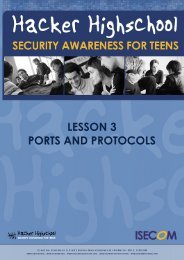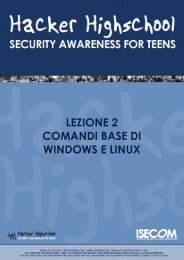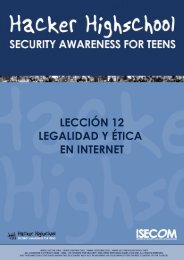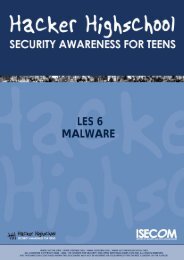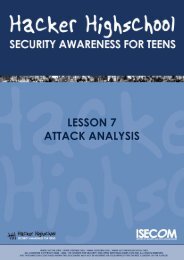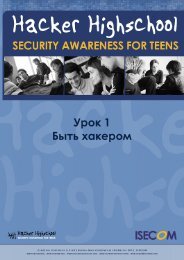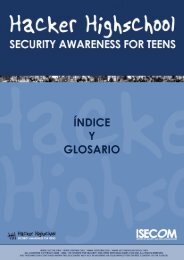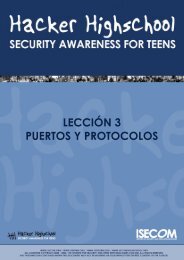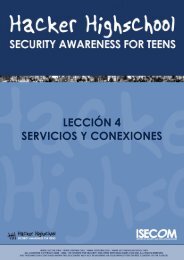HHS - Lesson 9 - Email Security - Hacker Highschool
HHS - Lesson 9 - Email Security - Hacker Highschool
HHS - Lesson 9 - Email Security - Hacker Highschool
Create successful ePaper yourself
Turn your PDF publications into a flip-book with our unique Google optimized e-Paper software.
LESSON 9<br />
E-MAIL SECURITY
LESSON 9 – E-MAIL SECURITY<br />
“License for Use” Information<br />
The following lessons and workbooks are open and publicly available under the following<br />
terms and conditions of ISECOM:<br />
All works in the <strong>Hacker</strong> <strong>Highschool</strong> project are provided for non-commercial use with<br />
elementary school students, junior high school students, and high school students whether in a<br />
public institution, private institution, or a part of home-schooling. These materials may not be<br />
reproduced for sale in any form. The provision of any class, course, training, or camp with<br />
these materials for which a fee is charged is expressly forbidden without a license including<br />
college classes, university classes, trade-school classes, summer or computer camps, and<br />
similar. To purchase a license, visit the LICENSE section of the <strong>Hacker</strong> <strong>Highschool</strong> web page at<br />
www.hackerhighschool.org/license.<br />
The <strong>HHS</strong> Project is a learning tool and as with any learning tool, the instruction is the influence<br />
of the instructor and not the tool. ISECOM cannot accept responsibility for how any<br />
information herein is applied or abused.<br />
The <strong>HHS</strong> Project is an open community effort and if you find value in this project, we do ask<br />
you support us through the purchase of a license, a donation, or sponsorship.<br />
All works copyright ISECOM, 2004.<br />
2
LESSON 9 – E-MAIL SECURITY<br />
Table of Contents<br />
“License for Use” Information............................................................................................................... 2<br />
Contributors..............................................................................................................................................4<br />
9.0 Introduction........................................................................................................................................5<br />
9.1 How E-mail Works..............................................................................................................................6<br />
9.1.1 E-mail Accounts......................................................................................................................... 6<br />
9.1.2 POP and SMTP............................................................................................................................6<br />
9.1.3 Web Mail.....................................................................................................................................7<br />
9.2 Safe E-mail Usage Part 1: Receiving...............................................................................................9<br />
9.2.1 Spam, Phishing and Fraud........................................................................................................9<br />
9.2.2 HTML E-Mail ................................................................................................................................9<br />
9.2.3 Attachment <strong>Security</strong>..................................................................................................................9<br />
9.2.4 Forged headers........................................................................................................................10<br />
9.3 Safe E-mail Usage Part 2: Sending................................................................................................ 12<br />
9.3.1 Digital Certificates................................................................................................................... 12<br />
9.3.2 Digital Signatures......................................................................................................................13<br />
9.3.3 Getting a certificate................................................................................................................14<br />
9.3.4 Encryption.................................................................................................................................14<br />
9.3.5 How does it work?....................................................................................................................14<br />
9.3.6 Decryption................................................................................................................................15<br />
9.3.7 Is Encryption Unbreakable?....................................................................................................15<br />
9.4 Connection <strong>Security</strong>.......................................................................................................................16<br />
3
LESSON 9 – E-MAIL SECURITY<br />
Contributors<br />
Stephen F. Smith, Lockdown Networks<br />
Chuck Truett, ISECOM<br />
Marta Barceló, ISECOM<br />
Kim Truett, ISECOM<br />
4
LESSON 9 – E-MAIL SECURITY<br />
9.0 Introduction<br />
Everyone uses e-mail. It is the second most used application on the internet next to your web<br />
browser. But what you might not realize is that a significant portion of network attacks and<br />
compromises originate through e-mail. And with respect to your privacy, misuse of e-mail has<br />
the potential to disclose either the contents of your message, or give a spammer information<br />
about you. The purpose of this module is to give you information on how e-mail works, safe e-<br />
mail usage, e-mail based attacks, and security strategies for e-mail.<br />
5
LESSON 9 – E-MAIL SECURITY<br />
9.1 How E-mail Works<br />
Just like airmail is sent through the air, 'e'-mail is sent through the 'e' – the 'e' in this case being<br />
the web of electronic connections within and between the networks that make up the<br />
Internet. When you send an e-mail from your computer, the data is sent from your computer<br />
to an SMTP server. The SMTP server then searches for the correct POP3 server and sends your<br />
e-mail to that server, where it waits until your intended recipient retrieves it.<br />
9.1.1 E-mail Accounts<br />
E-mail accounts are available through many different sources. You may get one through<br />
school, through your work or through your ISP. When you get an e-mail account, you will be<br />
given a two part e-mail address, in this form: username@domain.name. The first part,<br />
username identifies you on your network, differentiating you from all the other users on the<br />
network. The second part, domain.name is used to identify your specific network. The<br />
username must be unique within your network, just as the domain name must be unique<br />
among all the other networks on the Internet. However, user names are not unique outside of<br />
their networks; it is possible for two users on two different networks to share user names. For<br />
example, if there is one user with the address bill@bignetwork.net, there will not be another<br />
user on bignetwork.net whose user name is bill. However, bill@bignetwork.net and<br />
bill@smallnetwork.net are both valid e-mail addresses that can refer to different users.<br />
One of the first things that you will do when you are setting up your e-mail is to enter your e-<br />
mail address into your e-mail client program. Your e-mail client is the program that you will use<br />
to send and receive e-mails. Microsoft's Outlook Express may be the most widely known (since<br />
it comes free with every copy of a Microsoft operating system), but there are many others<br />
available for both Windows and Linux, including Mozilla, Eudora, Thunderbird and Pine.<br />
9.1.2 POP and SMTP<br />
After your e-mail client knows your e-mail address, it's going to need to know where to look for<br />
incoming e-mail and where to send outgoing e-mail.<br />
Your incoming e-mails are going to be on a computer called a POP server. The POP server –<br />
usually named something like pop.smallnetwork.net or mail.smallnetwork.net – has a file on it<br />
that is associated with your e-mail address and which contains e-mails that have been sent to<br />
you from someone else. POP stands for post office protocol.<br />
Your outgoing e-mails will be sent to a computer called a SMTP server. This server – named<br />
smtp.smallnetwork.net – will look at the domain name contained in the e-mail address of any<br />
e-mails that you send, then will perform a DNS lookup to determine which POP3 server it<br />
should send the e-mail to. SMTP stands for simple mail transfer protocol.<br />
When you start up your e-mail client, a number of things happen:<br />
1. the client opens up a network connection to the POP server<br />
2. the client sends your secret password to the POP server<br />
3. the POP server sends your incoming e-mail to your local computer<br />
4. the client sends your outgoing e-mail to the SMTP server.<br />
The first thing to note is that you do not send a password to the SMTP server. SMTP is an old<br />
protocol, designed in the early days of e-mail, at a time when almost everyone on the<br />
Internet knew each other personally. The protocol was written with the assumption that<br />
6
LESSON 9 – E-MAIL SECURITY<br />
everyone who would be using it would be trustworthy, so SMTP doesn't check to ensure that<br />
you are you. Most SMTP servers use other methods to authenticate users, but – in theory –<br />
anyone can use any SMTP server to send e-mail. (For more information on this, see section<br />
9.2.4 Forged Headers.)<br />
The second thing to note is that, when you send your secret password to the POP server, you<br />
send it in a plain-text format. It may be hidden by little asterisks on your computer screen, but<br />
it is transmitted through the network in an easily readable format. Anyone who is monitoring<br />
traffic on the network – using a packet sniffer, for instance – will be able to clearly see your<br />
password. You may feel certain that your network is safe, but you have little control over what<br />
might be happening on any other network through which your data may pass.<br />
The third, and possibly most important thing that you need to know about your e-mails, is that<br />
they are – just like your password – transmitted and stored in a plain-text format. It is possible<br />
that they may be monitored any time they are transferred from the server to your computer.<br />
This all adds up to one truth: e-mail is not a secure method of transferring information. Sure, it's<br />
great for relaying jokes, and sending out spunkball warnings, but, if you're not comfortable<br />
yelling something out through the window to your neighbor, then maybe you should think<br />
twice about putting it in an e-mail.<br />
Does that sound paranoid? Well, yeah, it is paranoid, but that doesn't necessarily make it<br />
untrue. Much of our e-mail communications are about insignificant details. No one but you,<br />
Bob and Alice, care about your dinner plans for next Tuesday. And, even if Carol desperately<br />
wants to know where you and Bob and Alice are eating next Tuesday, the odds are slim that<br />
she has a packet sniffer running on any of the networks your e-mail might pass through. But, if<br />
a company is known to use e-mail to arrange for credit card transactions, it is not unlikely to<br />
assume that someone has, or is trying to, set up a method to sniff those credit card numbers<br />
out of the network traffic.<br />
9.1.3 Web Mail<br />
A second option for e-mail is to use a web based e-mail account. This will allow you to use a<br />
web browser to check your e-mail. Since the e-mail for these accounts is normally stored on<br />
the web e-mail server – not on your local computer – it is very convenient to use these<br />
services from multiple computers. It is possible that your ISP will allow you to access your e-mail<br />
through both POP and the web.<br />
However, you must remember that web pages are cached or stored on local computers,<br />
sometimes for significant lengths of time. If you check your e-mail through a web based<br />
system on someone else's computer, there is a good chance that your e-mails will be<br />
accessible to someone else who uses that computer.<br />
Web based e-mail accounts are often free and easy to get. This means that they offer an<br />
opportunity for you to have several identities online. You can, for instance, have one e-mail<br />
address that you use only for friends and another that is only for relatives. This is usually<br />
considered acceptable, as long as you are not intentionally intending to defraud anyone.<br />
Exercises:<br />
1. You can learn a lot about how POP e-mail is retrieved by using the telnet program. When<br />
you use telnet instead of an e-mail client, you have to enter all the commands by hand<br />
(commands that the e-mail client program usually issues automatically). Using a web<br />
search engine, find the instructions and commands necessary to access an e-mail<br />
7
LESSON 9 – E-MAIL SECURITY<br />
account using the telnet program. What are the drawbacks to using this method to<br />
retrieve e-mail? What are some of the potential advantages?<br />
2. Find three organizations that offer web based e-mail services. What, if any, promises do<br />
they make about the security of e-mail sent or received using their services? Do they make<br />
any attempts to authenticate their users?<br />
3. (possibly homework) Determine the SMTP server for the email address you use most<br />
frequently.<br />
8
LESSON 9 – E-MAIL SECURITY<br />
9.2 Safe E-mail Usage Part 1: Receiving<br />
Everyone uses e-mail, and to the surprise of many people, your e-mail can be used against<br />
you. E-mail should be treated as a post card, in that anyone who looks can read the<br />
contents. You should never put anything in an ordinary e-mail that you don’t want to be<br />
read. That being said there are strategies for securing your e-mail. In this section we will cover<br />
safe and sane e-mail usage and how to protect your privacy online.<br />
9.2.1 Spam, Phishing and Fraud<br />
Everybody likes to get e-mail. A long time ago, in a galaxy far far away it used to be you only<br />
got mail from people you knew, and it was about things you cared about. Now you get e-<br />
mail from people you never heard of asking you to buy software, drugs, and real estate, not<br />
to mention help them get 24 million dollars out of Nigeria. This type of unsolicited advertising is<br />
called spam. It comes as a surprise to many people that e-mail they receive can provide a<br />
lot of information to a sender, such as when the mail was opened and how many times it was<br />
read, if it was forwarded, etc. This type of technology – called web bugs – is used by both<br />
spammers and legitimate senders. Also, replying to an e-mail or clicking on the unsubscribe<br />
link may tell the sender that they have reached a live address. Another invasion of privacy<br />
concern is the increasingly common “phishing” attack. Have you ever gotten an e-mail<br />
asking you to login and verify your bank or E-bay account information? Beware, because it is<br />
a trick to steal your account information. To secure yourself against these types of attacks,<br />
there are some simple strategies to protect yourself outlined below.<br />
9.2.2 HTML E-Mail<br />
One of the security concerns with HTML based e-mail is the use of web bugs. Web bugs are<br />
hidden images in your e-mail that link to the senders’ web server, and can provide them with<br />
notification that you have received or opened the mail. Another flaw with HTML e-mail is<br />
that the sender can embed links in the e-mail that identify the person who clicks on them.<br />
This can give the sender information about the status of the message. As a rule, you should<br />
use a mail client that allows you to disable the automatic downloading of attached or<br />
embedded images. Another problem is related to scripts in the e-mail that may launch an<br />
application ,if your browser has not been patched for security flaws.<br />
For web based e-mail clients, you may have the option of disabling the automatic download<br />
of images, or viewing the message as text. Either is a good security practice. The best way to<br />
protect yourself against HTML e-mail based security and privacy attacks is to use text based e-<br />
mail. If you must use HTML e-mail, beware!<br />
9.2.3 Attachment <strong>Security</strong><br />
Another real concern related to received e-mail security is attachments. Attackers can send<br />
you malware, viruses, Trojan horses and all sorts of nasty programs. The best defense against<br />
e-mail borne malware is to not open anything from anyone you don’t know. Never open a<br />
file with the extension .exe or .scr, as these are extensions that will launch an executable file<br />
that may infect your computer with a virus. For good measure, any files you receive should be<br />
saved to your hard drive and scanned with an antivirus program. Beware of files that look like<br />
a well known file type, such as a zip file. Sometimes attackers can disguise a file by changing<br />
the icon or hiding the file extension so you don’t know it is an executable.<br />
9
LESSON 9 – E-MAIL SECURITY<br />
9.2.4 Forged headers<br />
Occasionally you may receive an e-mail that looks like it is from someone you know, or from<br />
the “Administrator” or “Postmaster” or “<strong>Security</strong> Team” at your school or ISP. The subject may<br />
be “Returned Mail” or “Hacking Activity” or some other interesting subject line. Often there will<br />
be an attachment. The problem is that it takes no technical knowledge and about 10<br />
seconds of work to forge an e-mail address. (It also – depending on where you live – may be<br />
very illegal.)<br />
To do this, you make a simple change to the settings in your e-mail client software. Where it<br />
asks you to enter your e-mail address (under Options, Settings or Preferences) you enter<br />
something else. From here on out, all your messages will have a fake return address. Does this<br />
mean that you're safe from identification? No, not really. Anyone with the ability to read an e-<br />
mail header and procure a search warrant can probably figure out your identity from the<br />
information contained on the header. What it does mean is that a spammer can represent<br />
himself as anyone he wants to. So if Fannie Gyotoku [telecommunicatecreatures@cox.net]<br />
sells you a magic cell phone antenna that turns out to be a cereal box covered with tin foil,<br />
you can complain to cox.net, but don't be surprised when they tell you that there is no such<br />
user.<br />
Most ISPs authenticate senders and prevent relaying, which means that you have to be who<br />
you say you are to send mail via their SMTP server. The problem is that hackers and spammers<br />
often run an SMTP server on their PC, and thus don’t have to authenticate to send e-mail, and<br />
can make it appear any way they want. The one sure way to know if a suspicious e-mail is<br />
legitimate is to know the sender and call them up. Never reply to a message that you suspect<br />
may be forged, as this lets the sender know they have reached an actual address. You can<br />
also look at the header information to determine where the mail came from, as in the<br />
following example:<br />
This is an e-mail from someone I don’t know, with a suspicious attachment. Normally, I would<br />
just delete this but I want to know where it came from. So I’ll look at the message header. I<br />
use Outlook 2003 as my e-mail client, and to view the header you go to view>options and you<br />
will see the header information as below:<br />
Microsoft Mail Internet Headers Version 2.0<br />
10
LESSON 9 – E-MAIL SECURITY<br />
Received: from srv1.mycompany.com ([192.168.10.53]) by mx1.mycompany.com<br />
over TLS secured channel with Microsoft SMTPSVC(6.0.3790.0);<br />
Mon, 9 Aug 2004 11:20:18 -0700<br />
Received: from [10.10.205.241] (helo=www.mycompany.com)<br />
by srv1.mycompany.com with esmtp (Exim 4.30)<br />
id 1BuEgL-0001OU-8a; Mon, 09 Aug 2004 11:15:37 -0700<br />
Received: from kara.org (67.108.219.194.ptr.us.xo.net [67.108.219.194])<br />
by www.mycompany.com (8.12.10/8.12.10) with SMTP id i79IBYUr030082<br />
for ; Mon, 9 Aug 2004 11:11:34 -0700<br />
Date: Mon, 09 Aug 2004 14:15:35 -0500<br />
To: "Sales" <br />
From: "Sales" <br />
Subject:<br />
Message-ID: <br />
MIME-Version: 1.0<br />
Content-Type: multipart/mixed;<br />
boundary="--------cfwriebwwbnnfkkmojga"<br />
X-Scan-Signature: 178bfa9974a422508674b1924a9c2835<br />
Return-Path: sales@innovonics.com<br />
X-OriginalArrivalTime: 09 Aug 2004 18:20:18.0890 (UTC) FILETIME=<br />
[868FEAA0:01C47E3D]<br />
----------cfwriebwwbnnfkkmojga<br />
Content-Type: text/html; charset="us-ascii"<br />
Content-Transfer-Encoding: 7bit<br />
----------cfwriebwwbnnfkkmojga<br />
Content-Type: application/octet-stream; name="price_08.zip"<br />
Content-Transfer-Encoding: base64<br />
Content-Disposition: attachment; filename="price_08.zip"<br />
----------cfwriebwwbnnfkkmojga—<br />
Now, the part I’m interested in is highlighted above. Note that the “Received” is from<br />
kara.org at an IP that appears to be an xo.net DSL line, which does not agree with<br />
innovonics.com, the purported sender.<br />
Also, if I look up innovonics.com’s mail server using nslookup, its address comes back as<br />
follows:<br />
C:\>nslookup innovonics.com<br />
Server: dc.mycompany.com<br />
Address: 192.168.10.54<br />
11
LESSON 9 – E-MAIL SECURITY<br />
Non-authoritative answer:<br />
Name:<br />
innovonics.com<br />
Address: 64.143.90.9<br />
So, my suspicion was correct, and this is an e-mail that is carrying some malware in an<br />
executable file posing as a zip file. The malware has infected the person’s computer on the<br />
DSL line, which is now a zombie, sending copies of the malware to everyone in the infected<br />
computers address book. I’m glad I checked it out!<br />
Exercises:<br />
1. Citbank and PayPal are two of the most common targets of phishing emails. Research<br />
what Citibank or PayPal are doing to fight / control phishing.<br />
2. Research whether your bank or credit card holder has a published statement about the<br />
use of email and personal information.<br />
3. (possibly homework) Research a spam email you have received and see if you can<br />
determine the real source.<br />
9.3 Safe E-mail Usage Part 2: Sending<br />
Sending mail is a little more care free. There are some things you can do to make sure your<br />
conversation is secure though. The first is to ensure your connection is secure (see section 9.4<br />
Connection <strong>Security</strong> for more information). There are also methods to allow you to digitally<br />
sign your messages, which guarantees that the message is from you and has not been<br />
tampered with en route. And for maximum security, you can encrypt your messages to make<br />
sure no one reads them.<br />
Digital signatures prove who e-mail comes from, and that it has not been altered in transit. If<br />
you establish the habit of using digital signatures for important e-mail, you will have a lot of<br />
credibility if you ever need to disown forged mail that appears to be from you. They also allow<br />
you to encrypt e-mail so that no one can read it except the recipient. PGP in particular offers<br />
high levels of encryption which to break would require extreme computing power.<br />
9.3.1 Digital Certificates<br />
A digital certificate is unique to an individual, kind of like a drivers license or passport, and is<br />
composed of 2 parts. These parts are a public and private key. The certificate is unique to<br />
one person, and typically certificates are issued by a trusted Certificate Authority, or CA. The<br />
list of Certificate Authorities you trust is distributed automatically (if you are a Microsoft<br />
Windows User) by Windows Update and the list is accessible in your browser under<br />
tools>internet options>content>certificates. You can go here to view certificates installed on<br />
your machine (yours and others), and other certificate authorities you trust.<br />
12
LESSON 9 – E-MAIL SECURITY<br />
You can disable the automatic update of CAs, and choose to remove all CAs from the list,<br />
although this is not recommended. Instructions on how to do this are on Microsoft’s web site.<br />
9.3.2 Digital Signatures<br />
A digital signature is generated by your e-mail software and your private key to assure the<br />
authenticity of your e-mail. The purpose of the signature is twofold. The first is to certify it<br />
came from you. This is called non-repudiation. The second is to ensure the contents have not<br />
been altered. This is called data integrity. The way an e-mail program accomplishes this is by<br />
running the contents of your message through a one way hash function. This produces a fixed<br />
size output of your e-mail called a message digest. This is a unique value, and if the<br />
mathematical algorithm that produces it is strong, the message digest has the following<br />
attributes.<br />
<br />
<br />
The original message can’t be reproduced from the digest.<br />
Each digest is unique.<br />
After the digest is created, it is encrypted with your private key. The encrypted digest is<br />
attached to the original message along with your public key. The recipient then opens the<br />
message, and the digest is decrypted with your public key. The digest is compared to an<br />
identical digest generated by the recipients’ mail program. If they match, then you’re done.<br />
If not, your mail client will let you know the message has been altered. There are 2 types of<br />
signing / encryption functions, S/MIME and PGP. S/MIME is considered to be the corporate<br />
and government choice, possibly because it uses the less labor intensive certificate authority<br />
model for authentication, and because it is more easily implemented through Microsoft's<br />
Outlook Express e-mail program. PGP is more often the choice of the computer user<br />
community, because it is based on a non-centralized web of trust for authentication, where a<br />
user's trustworthiness is validated through the 'friend of a friend' system, where you agree that,<br />
if you trust me, then you can also trust those people who I trust, and because members of the<br />
computer user community don't really care if it takes them four hours to figure out how to<br />
13
LESSON 9 – E-MAIL SECURITY<br />
make PGP work with Thunderbird – they consider these types of challenges to be a form of<br />
recreation.<br />
9.3.3 Getting a certificate<br />
If you are interested in getting a digital certificate or digital ID, you need to contact a<br />
Certificate Authority (Verisign and thawte are the most well known, although a web search<br />
may find others.) Both require you to provide identification to prove to them that you are who<br />
you are. You can get a free certificate from thawte, but they require a significant amount of<br />
personal information, including a government identification number (such as a passport, tax<br />
id or driver's license). Verisign charges a fee for its certificate and requires that you pay this fee<br />
with a credit card, but asks for less personal information. (Presumably, Verisign is relying on the<br />
credit card company to validate your personal information.) These requests for information<br />
may seem intrusive, but remember, you are asking these companies to vouch for your<br />
trustworthiness. And – as always – check with your parents or guardians before you give out<br />
any personal information (or run up large balances on their credit cards).<br />
The biggest disadvantage to using a certificate authority is that your private key is available<br />
to someone else – the certificate authority. If the certificate authority is compromised, then<br />
your digital ID is also compromised.<br />
9.3.4 Encryption<br />
As an additional layer of security, you can encrypt your e-mail. Encryption will turn your e-mail<br />
text into a garbled mess of numbers and letters that can only be read by its intended<br />
recipient. Your deepest secrets and your worst poetry will be hidden from all but the most<br />
trusted eyes.<br />
However, you must remember, that, while this may sound good to you – and to all of us who<br />
don't really wish to be exposed to bad poetry – some governments do not approve. Their<br />
arguments may – or may not – be valid (you can discuss this amongst yourselves), but validity<br />
is not the point. The point is that, depending on the laws of the nation in which you live,<br />
sending an encrypted e-mail may be a crime, regardless of the content.<br />
9.3.5 How does it work?<br />
Encryption is fairly complicated, so I’ll try to explain it in a low tech way:<br />
Jason wants to send an encrypted message. So the first thing Jason does is go to a<br />
Certificate Authority and get a Digital Certificate. This Certificate has two parts, a Public Key<br />
and a Private Key.<br />
If Jason wants to receive and send encrypted messages with his friend Kira, they must first<br />
exchange Public keys. If you retrieve a public key from a Certificate Authority that you have<br />
chosen to trust, the key can be verified back to that certifying authority automatically. That<br />
means your e-mail program will verify that the certificate is valid, and has not been revoked.<br />
If the certificate did not come from an authority you trust, or is a PGP key, then you need to<br />
verify the key fingerprint. Typically this is done separately, by either a face to face exchange<br />
of the key or fingerprint data.<br />
Now let's assume that both Kira and Jason are using compatible encryption schemes, and<br />
have exchanged signed messages, so they have each others public keys.<br />
14
LESSON 9 – E-MAIL SECURITY<br />
When Jason wants to send an encrypted message, the encryption process begins by<br />
converting the text of Jason’s message to a pre hash code. This code is generated using a<br />
mathematical formula called an encryption algorithm. There are many types of algorithms,<br />
but for e-mail S/MIME and PGP are most common.<br />
The hash code of Jason’s message is encrypted by the e-mail program using Jason’s private<br />
key. Jason then uses Kira’s public key to encrypt the message, so only Kira can decrypt it with<br />
her private key, and this completes the encryption process.<br />
9.3.6 Decryption<br />
So Kira has received an encrypted message from Jason. This typically is indicated by a lock<br />
Icon on the message in her in box. The process of decryption is handled by the e-mail<br />
software, but what goes on behind the scenes is something like this: Kira’s e-mail program<br />
uses her private key to decipher the encrypted pre hash code and the encrypted message.<br />
Then Kira’s e-mail program retrieves Jason’s public key from storage (remember, we<br />
exchanged keys earlier). This public key is used to decrypt the pre hash code and to verify the<br />
message came from Jason. Kira’s e-mail program then generates a post hash code from the<br />
message. If the post hash code equals the pre hash code, the message has not been altered<br />
en route.<br />
Note: if you lose your private key, your encrypted files become useless, so it is important to<br />
have a procedure for making backups of your private and public keys.<br />
9.3.7 Is Encryption Unbreakable?<br />
According to the numbers, the level of encryption offered by, for example, PGP is<br />
unbreakable. Sure, a million computers working on breaking it would eventually succeed, but<br />
not before the million monkeys finished their script for Romeo and Juliet. The number theory<br />
behind this type of encryption involves factoring the products of very large prime numbers,<br />
and, despite the fact that mathematicians have studied prime numbers for years, there's just<br />
no easy way to do it.<br />
But encryption and privacy are about more than just numbers. However, if someone else has<br />
access to your private key, then they have access to all of your encrypted files. Encryption<br />
only works if it is part of a larger security framework which offers protection to both your<br />
private key and your pass-phrase.<br />
Exercises:<br />
1. Is encryption of email legal in the country that you reside in? Find one other country that it<br />
is legal in,and one country where it is illegal to encrypt email.<br />
2. Science fiction writers have imagined two types of futures, one in which people's lives are<br />
transparent, that is, they have no secrets, and one in which everyone's thoughts and<br />
communications are completely private. Phil Zimmerman, creator of PGP, believes in<br />
privacy as a source of freedom. Read his thoughts on why you need PGP at<br />
http://www.pgpi.org/doc/whypgp/en/. Then look at science fiction writer David Brin's<br />
article 'A Parable about Openness' at http://www.davidbrin.com/akademos.html in which<br />
he makes a number of points advocating openness as a source of freedom. Discuss these<br />
two opposing viewpoints. Which do you prefer? Which do you think would most likely<br />
succeed? What do you think the future of privacy will be like?<br />
15
LESSON 9 – E-MAIL SECURITY<br />
9.4 Connection <strong>Security</strong><br />
Last but not least is connection security. For web mail, ensure you are using an SSL<br />
connection to your ISPs e-mail. A small lock icon will appear in the bar at the bottom of your<br />
browser. If you are using POP and an e-mail client, ensure that you have configured your e-<br />
mail client to use SSL with POP on port 995 and SMTP on port 465. This encrypts your mail from<br />
you to your server, as well as protecting your POP / SMTP username and password. Your ISP<br />
should have a how-to on their web site to configure this. If they don’t offer a secure POP /<br />
SMTP connection, change ISPs!<br />
Exercise:<br />
If you have an e-mail account, find out if your account is using SSL for its connection. How do<br />
you check this in your e-mail client? Does your ISP provide information regarding an SSL<br />
connection?8.0 Introduction<br />
16
LESSON 9 – E-MAIL SECURITY<br />
Further Reading<br />
Can someone else read my e-mail?<br />
http://www.research.att.com/~smb/securemail.html<br />
MIT's PGP freeware page<br />
http://web.mit.edu/network/pgp.html<br />
General news on Internet privacy issues:<br />
Electronic Privacy Information Center<br />
http://www.epic.org/<br />
and<br />
Electronic Frontier Foundation<br />
http://www.eff.org/<br />
More about PGP<br />
http://www.openpgp.org/index.shtml<br />
How Reading an <strong>Email</strong> Can Compromise Your Privacy<br />
http://email.about.com/od/staysecureandprivate/a/webbug_privacy.htm<br />
Avoiding E-mail Viruses<br />
http://www.ethanwiner.com/virus.html<br />
A Brief Overview of E-mail <strong>Security</strong> Questions (with a short advertisement at the end)<br />
http://www.zzee.com/email-security/<br />
A Brief Overview of E-mail <strong>Security</strong> Questions (with no advertisement)<br />
http://www.claymania.com/safe-hex.html<br />
Windows Based E-mail Precautions<br />
http://www.windowsecurity.com/articles/Protecting_<strong>Email</strong>_Viruses_Malware.html<br />
http://computer-techs.home.att.net/email_safety.htm<br />
Differences Between Linux and Windows Viruses (with information on why most Linux e-mail<br />
programs are more secure)<br />
http://www.theregister.co.uk/2003/10/06/linux_vs_windows_viruses/<br />
17



